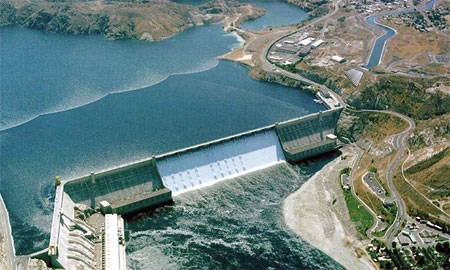To drive economic growth, Cameroon’s Government has identified strategic developments to unfold in the years to come. As formulated in the “Vision 2035” paper, it is in cooperation with the private sector and development partners with long-term goals in mind; specifically, the improvement of water and energy resources infrastructure.
New York-based
Hydromine’s projects are a perfect example of successful public-private partnership in Cameroon. The company is active in natural resources, power generation and sustainable development of projects in energy technology, with operations in Libya, Brazil, the US, Poland, the Caribbean and the UK. Its main undertakings in Cameroon are a bauxite/alumina project, the tapping of hydroenergy from two sites and rail infrastructure to the port of Kribi. The objective is to produce energy to process bauxite into alumina and trade it internationally from Kribi.
Pairing with the public sector is key for successful impact on socio-economic growth. Minister for Economy, Planning and Regional Development Louis-Paul Motazé says, “We are putting in place conditions for our growth and employment strategy. There were some prerequisites, one of which was energy. The solution to this problem is being put in place steadily.” Already, the development plan for 2010-2020 contained in the Growth and Employment Strategy Paper is expected to receive fresh impetus this year and start showing tangible results on the ground.
On a wider level, Cameroon aims to become an emerging country, with specific goals in the energy and water sector. New investment needs to be channelled into the improvement of supply infrastructures. The results will obviously be the creation of jobs, because, as the minister says, "everything we are doing is aimed at boosting growth and job creation.” So, when Hydromine sought to extend its bauxite mining licences, an implicit condition was to utilise the country’s vast hydroelectric resources.
THE GOVERNMENT’S APPROACH TO THEIR PARTNERSHIP HAS BEEN “OPEN AND RESPONSIVE”
|
At the request of the Government, the company identified two high potential power generation sites, Mouséré and Grand Eweng. Studies show that both can provide low-cost energy at exceptionally high efficiency.
The Grand Eweng facility could boast a capacity factor of up to 85 per cent (50 per cent is normally considered good). It would serve as power source to a new aluminium smelter, which in turn would generate 2,000 direct jobs and a further 9,000 during construction. Meanwhile, the Mouséré facility in the Adamaoua region, with an estimated 55-65 per cent capacity factor, could feed a large-scale agro-industrial project similar to those pioneered in Brazil. Any extra energy produced from these sites could be sold to the Nigerian power grid.
In Hydromine CEO Peter L Briger’s own words, the Government’s approach to their partnership has been “open and responsive”. Clearly, improving the visibility of investment opportunities is a significant part of Cameroon’s effort to strengthen public-private relations.
Interview with: Peter L. Briger, CEO Hydromine.
Tell us about Cameroon’s hydroelectric capacity, the second largest in Africa.One way we rate projects is by looking at the water flow and the ratio of guaranteed annual power to rated capacity. On Cameroon’s larger projects, efficiency reaches over 80% – which is extraordinary. The construction cost is 40% lower than we and the African Development Bank forecasted, thanks to the availability and quality of local materials. It exceeded our expectations.
How is investment facilitated here?The Government is open and responsive, and has been a great partner in all of this. There is an exchange of information and the Government will express its objectives very clearly, so one sees how to get there.
Cameroon is extremely rich in natural resources, with great opportunities to maximise them. What about the people?The people’s can-do attitude and work ethic are an important part of the country’s wealth. An interesting quality to Cameroon is not only the diversity of resources but also the diversity of people from all religions and from over 250 tribes. This diversity model works. One thing the rest of the world can learn from them is how they work together.
How can Hydromine contribute to the country’s socio-economic growth in the mid to long term?We see our role as solving problems, identifying players and bringing parties together. Cameroon has similarities with Brazil 40 years ago, and it is our wish to develop like Brazil. The ingredients are all here.
Some final words on Cameroon’s potential?Cameroon is a very special country. It has the material resources, but also the intangible resources, such as the way people get along. When you put this together, you have the basis for first-grade projects to be achieved and great value to be invested. The future is virtually unlimited.

0 COMMENTS